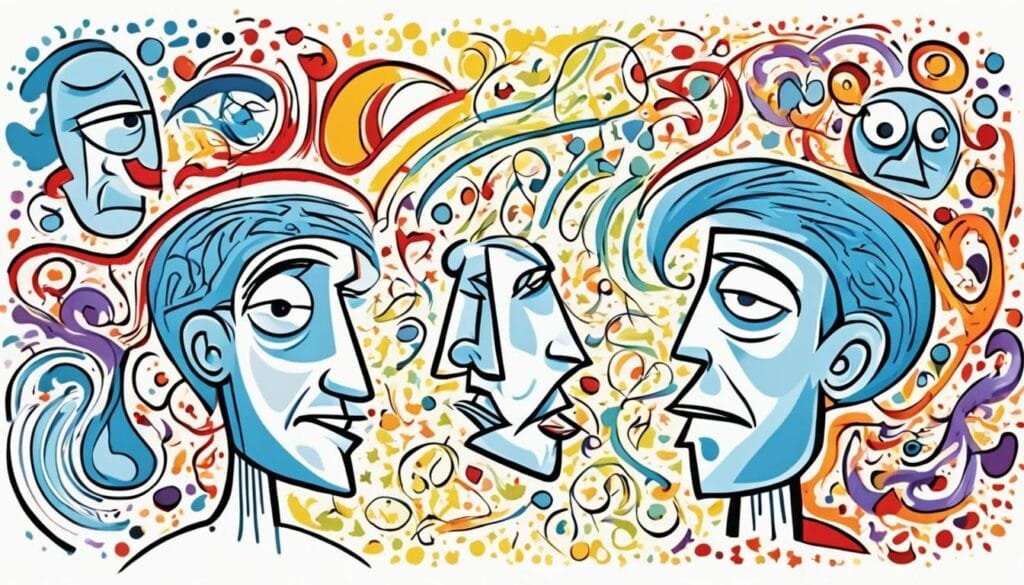Sexual libido is key to our overall health. It affects our social, mental, emotional, and physical health. Many people face issues with sexual response, desire, orgasm, or pain. This is known as sexual dysfunction. Up to 43% of women and 31% of men report some degree of sexual dysfunction.
The causes of sexual dysfunction are complex. They involve physiological, hormonal, psychological, and social factors. These disruptions can lead to challenges in sexual intimacy and low libido. Understanding these causes is key to addressing sexual dysfunction and improving sexual health.

Key Takeaways
- Sexual dysfunction is a common issue, affecting up to 43% of women and 31% of men.
- It can impact social, mental, emotional, and physical well-being.
- Causes of sexual dysfunction are complex, involving a mix of physiological, hormonal, psychological, and social factors.
- Proper diagnosis and treatment are essential to address the underlying causes and improve sexual health.
- Understanding the causes of sexual dysfunction is the first step in finding effective solutions.
What is Sexual Dysfunction?
Sexual dysfunction means having trouble that stops you from feeling satisfied with sex. The DSM-5 says a healthcare expert can diagnose this if you have symptoms most of the time, for at least 6 months, and it makes you really upset.
Diagnostic Criteria and Categories
The four main types of sexual dysfunction are:
- Desire disorder
- Arousal disorders
- Orgasm dysfunction
- Pain disorders
These types are based on the kind of dysfunction you face, not if it’s physical or mental.
| Category | Definition |
|---|---|
| Desire disorder | A persistent or recurrent lack of sexual or erotic thoughts, fantasies, and desire for sexual activity. |
| Arousal disorders | The inability to get or keep sexual excitement, causing a lot of distress or problems with others. |
| Orgasm dysfunction | A persistent delay in, or not having, orgasm after feeling normal sexual excitement. |
| Pain disorders | Recurrent or ongoing pain in the genital or pelvic area during sexual activity. |
These diagnostic criteria and types of sexual dysfunction help doctors figure out and fix the issues people face.
Causes of Sexual Dysfunction in Women
Many things can cause sexual dysfunction in women. These include physical, hormonal, psychological, and social factors. These can affect a woman’s sexual desire, arousal, and satisfaction.
Physical Factors
Physical conditions like cancer, kidney failure, and heart disease can affect sexual function. Some medicines, including antidepressants and blood pressure drugs, can also lower sexual desire and orgasm ability.
Hormonal Factors
Hormonal changes, such as low estrogen after menopause or after childbirth, can change genital tissues and sexual response. This can also affect desire.
Psychological and Social Factors
Things like untreated anxiety, depression, and stress can cause sexual dysfunction. So can a history of sexual abuse, relationship problems, and cultural or religious beliefs. These beliefs can make people feel guilty or ashamed about sex.
- Anxiety and depression can lower sexual desire and arousal.
- Relationship conflicts and poor communication can make sex less satisfying.
- Cultural or religious beliefs can affect attitudes towards sex and cause guilt or shame.
“Understanding the diverse factors that can contribute to sexual dysfunction in women is crucial for providing effective and tailored treatment.”
Healthcare providers can help women with sexual dysfunction by addressing physical, hormonal, psychological, and social factors. This can improve their sexual health and well-being.
Low Sexual Desire in Women
Low sexual desire, also known as hypoactive sexual desire disorder (HSDD), is the most common type of female sexual dysfunction. It means a woman doesn’t feel interested in sex and doesn’t want to have it, which causes a lot of distress. This issue can happen at any time in a woman’s life, in some sexual situations, or in all of them.
There are many reasons why women might have low sexual desire. These include physical, hormonal, psychological, and social factors. It’s important to know what causes it to manage and treat it well.
- Physical factors like chronic health issues, certain medicines, or problems with pelvic organs can lower a woman’s libido.
- Hormonal changes during menopause, pregnancy, or after having a baby can also make a woman less interested in sex.
- Psychological and social factors like stress, anxiety, relationship problems, and cultural or societal expectations can greatly affect a woman’s sexual desire.
If you keep feeling low sexual desire or HSDD, you should see a doctor. A healthcare provider can find out why and create a plan just for you.
“Understanding the root causes of low sexual desire is crucial for effective management and treatment of this disorder.”
Your sexual health is key to your overall well-being. By dealing with low sexual desire, you can make your life better and improve your relationships.
Sexual Arousal Disorders in Women
Sexual arousal disorders in women can be complex and tough. These disorders make it hard to get or stay aroused during sex, even when you want to. You might not get enough vaginal lubrication, feel less in your genital area, or take longer to get aroused and orgasm.
These disorders have many causes, including physical, hormonal, and psychological factors. Knowing the causes is key to treating and managing them.
Physical Factors
Physical issues can lead to sexual arousal disorders in women, such as:
- Cardiovascular disease
- Neurological conditions
- Chronic pain disorders
- Certain medications
Hormonal Factors
Hormonal imbalances, especially with estrogen and testosterone, affect sexual arousal in women. Menopause, pregnancy, and some medical treatments can mess with the hormonal balance. This can make it hard to get aroused.
Psychological and Social Factors
Psychological and social factors can also play a part. These include:
- Stress and anxiety
- Depression
- Relationship issues
- Body image concerns
It’s important to tackle the causes of sexual arousal disorders in women for better sexual health. If you’re facing these issues, see a healthcare professional for help. They can give you a full check-up and a treatment plan just for you.
| Factors Contributing to Sexual Arousal Disorders in Women | Examples |
|---|---|
| Physical | Cardiovascular disease, neurological conditions, chronic pain disorders, certain medications |
| Hormonal | Menopause, pregnancy, medical treatments |
| Psychological and Social | Stress, anxiety, depression, relationship issues, body image concerns |
Orgasmic Disorders in Women
Orgasmic disorders in women are common but often ignored. They involve trouble reaching orgasm, even with enough arousal and stimulation. These disorders can be primary or secondary. Primary means never having had an orgasm. Secondary means having had one before but not anymore.
The reasons for orgasmic disorders in women are many. They can come from physical, hormonal, or psychological issues. Physical problems like nerve damage or certain drugs can stop orgasm. Hormones, especially estrogen and testosterone, can also play a part in female orgasmic disorder. Stress, anxiety, relationship problems, and cultural norms can also affect orgasm.
Women facing orgasm issues should talk to healthcare experts. A detailed check-up can find the root cause and create a treatment plan. This plan might include physical, hormonal, and mental help. It also means talking openly with a partner.
Understanding orgasmic disorders in women and getting the right medical care is key. It helps women deal with this common issue. This can improve their sexual health and happiness.
Sexual Pain Disorders in Women
Women can face various sexual pain issues that affect their intimate lives. Dyspareunia and vaginismus are two common ones. Dyspareunia means pain during sex. Vaginismus is when the muscles around the vagina tighten without control, making sex hard or impossible.
These pain issues can come from physical or mental causes. Physical reasons might be infections, hormonal shifts, or conditions like endometriosis. Mental and social factors, like past trauma, relationship problems, or cultural beliefs, also play a part.
Sexual pain disorders can really affect a woman’s life. They can lead to stress, worry, and feeling less fulfilled in sex. Women facing these problems should get medical help and look into treatments to fix the issue and improve their sex life.
| Condition | Definition | Potential Causes |
|---|---|---|
| Dyspareunia | Pain during sexual intercourse | Infections Hormonal changes Endometriosis Vulvodynia Pelvic floor dysfunction |
| Vaginismus | Involuntary tightening of the vaginal muscles | Past sexual trauma Relationship issues Cultural taboos Anxiety or fear of intercourse |
It’s important to understand and deal with sexual pain in women for a healthy sex life. If you’re dealing with these problems, talk to a healthcare provider. They can guide you to the right treatment and support.
Libido and Sexual Dysfunction in Men
Sexual dysfunction affects over 50% of men between 40-70 years old. The main issues are erectile dysfunction (ED) and ejaculation disorders. These problems can come from physical, hormonal, or mental issues, affecting how men respond sexually.
Erectile Dysfunction
ED means a man can’t get or keep an erection for sex. It can happen for many reasons, like health problems, some medicines, or stress, anxiety, and depression.
Ejaculation Disorders
Ejaculation issues include premature ejaculation, delayed ejaculation, and retrograde ejaculation. Premature ejaculation is when a man ejaculates too quickly. Delayed ejaculation means it’s hard to ejaculate even with enough stimulation. Retrograde ejaculation happens when semen goes into the bladder instead of out through the urethra.
| Ejaculation Disorder | Description |
|---|---|
| Premature Ejaculation | Rapid, uncontrolled ejaculation that occurs before or shortly after penetration |
| Delayed Ejaculation | Persistent inability to ejaculate despite adequate sexual stimulation |
| Retrograde Ejaculation | Semen flows backward into the bladder instead of out through the urethra |
Knowing about sexual dysfunction in men is key to finding help. It’s important to understand the causes and types of these issues to get the right treatment.
Risk Factors for Sexual Dysfunction
Understanding sexual dysfunction can be tough, but knowing the risk factors helps. Factors like depression and anxiety to heart disease and neurological conditions can affect sexual health.
Mental health conditions like depression and anxiety are big risks. They can lower libido and affect sexual function. Some medicines, like antidepressants and blood pressure drugs, can also hurt sexual performance.
Physical health issues, such as heart disease and neurological conditions, are risks too. Heart problems can affect blood flow. Neurological issues, like spinal cord injury or multiple sclerosis, can mess with the nerves needed for sex.
Hormonal imbalances, gynecological conditions (like vulvovaginal atrophy or infections), and past sexual abuse are risks too. These affect both men and women.
Knowing these risks is key for those wanting to improve their sexual health. Working with healthcare pros can help find ways to lessen these risks. This can lead to better sexual well-being.
“Understanding the underlying causes of sexual dysfunction is the first step towards finding effective solutions.”
When to See a Doctor
If you’re facing sexual dysfunction that’s causing stress or affecting your relationship, it’s key to see a healthcare provider. This issue can greatly lower your quality of life. It might also be a sign of a health problem that needs care.
Here are some signs you should get medical help for sexual issues:
- Persistent trouble with sexual arousal, desire, or orgasm
- Unexplained pain or discomfort during sexual activity
- Significant changes in sexual function that worry you or affect your relationship
- Any sexual dysfunction that’s causing you distress or impacting your well-being
Sexual dysfunction is quite common, and there are treatments that work. Don’t be shy to speak with a healthcare provider if you’re facing issues. They can find the root cause and create a plan just for you.
“Open communication with your healthcare provider is key when it comes to addressing sexual dysfunction. They are there to help, not judge.”
Getting medical help for sexual issues is the first step to bettering your sexual health and overall well-being.

Diagnosis of Sexual Dysfunction
Diagnosing sexual dysfunction starts with a detailed look at a person’s medical history and physical check-up. Doctors will ask about symptoms, recent health issues, and current medicines. This helps them understand why the sexual dysfunction is happening.
Medical History and Tests
Doctors will ask about your sexual health during the diagnosis. They want to know when the problems started, how long they last, and how severe they are. This information helps them find out what might be causing the issues.
They might also order lab tests to check for medical conditions. These tests could include:
- Thyroid function tests to check thyroid hormone levels
- Hormone profiles to look at sex hormone levels, like testosterone, estrogen, and testosterone
- Cholesterol level assessments to check for heart health
A physical exam, including a check of the genitals, might also be done. This helps rule out physical problems. If needed, doctors might refer you to specialists like urologists, gynecologists, or psychologists for more tests and treatment.
“Diagnosing sexual dysfunction is a crucial first step in addressing the issue and developing an effective treatment plan.”
By using a detailed medical history, specific lab tests, and a physical exam, doctors can understand the causes of sexual dysfunction. This helps them create a good treatment plan.
Treatments for Sexual Dysfunction
Dealing with sexual dysfunction means looking at both physical and mental sides. There are many treatments available, from hormone therapy to counseling. These help individuals and couples face their intimate challenges.
Physical Treatments
For those facing physical issues, medical help can be a big step forward. Doctors might treat hormonal imbalances or chronic illnesses with medications or hormone therapy. They can also prescribe creams or pills to help with sexual arousal.
In some cases, surgery like penile implants is an option to improve erectile function. These treatments aim to boost the body’s natural sexual responses.
Psychological Treatments
Stress, anxiety, and relationship problems can hurt sexual desire and performance. Cognitive-behavioral therapy, sex therapy, and couple’s counseling can help. These therapies focus on the mental and emotional sides of sexual issues.
They help people and their partners understand their feelings and communication about sex. This leads to better coping strategies and ways to build intimacy.
Sometimes, antidepressants are given along with these therapies for mental health issues linked to sexual problems.
By tackling both physical and mental sides of sexual dysfunction, people can find lasting solutions. This helps them get back their sexual health.
Outlook and Living with Sexual Dysfunction
Living with sexual dysfunction can be different for everyone. Some issues might be short-term and can be fixed, while others might last a long time. But, with the right treatment, many people can get better and improve their life quality.
Working with healthcare providers is key when you have sexual dysfunction. Getting a full check-up and diagnosis helps make a good treatment plan. This plan might include physical, hormonal, and mental help, based on what you need.
Medical help is just part of it. Finding support and learning how to cope is also vital. This could mean joining groups, seeing a therapist, or managing stress. By dealing with both the body and mind, you can better handle your issues and improve your life.
Dealing with sexual dysfunction isn’t always easy, but it’s possible to manage. With the right support and approach, many people can keep a good sex life. By staying informed, getting professional help, and taking care of yourself, you can work towards a better outlook.
Coping Strategies for Living with Sexual Dysfunction
- Communicate openly with your partner about your experiences and concerns
- Explore alternative forms of intimacy and sexual expression
- Practice stress management techniques, such as meditation or yoga
- Seek support from a therapist or counselor
- Join a support group to connect with others facing similar challenges
- Maintain a healthy lifestyle, including regular exercise and a balanced diet
| Aspect | Description |
|---|---|
| Outlook for Sexual Dysfunction | The outlook for individuals with sexual dysfunction can vary, with some conditions being temporary and treatable, while others may be chronic and require ongoing management. However, with the right approach and treatment plan, many people can improve their sexual health and quality of life. |
| Living with Sexual Dysfunction | Living with sexual dysfunction involves working closely with healthcare providers, seeking support, and developing coping strategies. This may include communication, exploring alternative intimacy, stress management, therapy, support groups, and maintaining a healthy lifestyle. |
By tackling both the body and mind, you can improve your sexual health and life quality.

“With the right support and treatment, many individuals with sexual dysfunction can find ways to manage their condition and maintain a fulfilling sex life.”
Conclusion
Sexual dysfunction is a complex issue that affects many people. It’s important to understand the different types, causes, and treatments available. This knowledge helps people take charge of their sexual health.
Professional support and personalized treatment plans are key. A holistic approach to sexual health can really help. These steps can change lives for the better.
Sexual dysfunction is a common issue that shouldn’t be ignored. Open communication and medical checks are crucial. Many people find solutions that help them regain their sexual function and improve their life quality.
By facing this issue together, we can reduce the stigma around sexual health. This lets people focus on their intimate well-being. It’s a journey that leads to better relationships and overall well-being for everyone.
Sexual dysfunction is something that can be managed. With the right support and resources, people can take back control of their sexual lives. Prioritizing sexual health leads to stronger relationships and better well-being for individuals and communities.
FAQ
What is sexual dysfunction?
Sexual dysfunction means having ongoing problems with sexual response, desire, orgasm, or pain. These issues can cause distress and affect relationships. They can also impact mental, emotional, and physical health.
What are the main categories of sexual dysfunction?
There are four main types of sexual dysfunction: 1) Desire disorder, 2) Arousal disorders, 3) Orgasm dysfunction, and 4) Pain disorders.
What are the common causes of sexual dysfunction in women?
Many things can cause sexual dysfunction in women. These include physical, hormonal, psychological, and social factors. Issues like medical conditions, certain medicines, hormonal changes, anxiety, depression, relationship problems, and cultural/religious beliefs can affect sexual health.
What is low sexual desire (hypoactive sexual desire disorder) in women?
Low sexual desire, or hypoactive sexual desire disorder (HSDD), is the most common sexual problem in women. It means not wanting sex and not being interested in it, which causes distress.
What are sexual arousal disorders in women?
Women with arousal disorders have trouble getting or staying aroused during sex, even if they want to. They might not get wet, feel less in their genital area, or take longer to get aroused and orgasm.
What are orgasmic disorders in women?
Orgasmic disorders in women make it hard to have an orgasm, even when they’re turned on and stimulated. This can be a new problem or something they used to be able to do but can’t anymore.
What are sexual pain disorders in women?
Sexual pain disorders in women include dyspareunia (pain during sex) and vaginismus (muscles tightening without control). These can make sex painful and cause a lot of distress.
What are the common types of sexual dysfunction in men?
Men often face erectile dysfunction (ED) and issues with ejaculation. These can be premature ejaculation, delayed ejaculation, or retrograde ejaculation.
What are the risk factors for sexual dysfunction?
Risk factors for sexual dysfunction include depression, anxiety, heart and blood vessel diseases, neurological conditions, some medicines, stress, and a history of sexual abuse.
When should someone seek medical help for sexual dysfunction?
If sexual problems cause distress or strain relationships, see a healthcare provider for help and evaluation.
How is sexual dysfunction diagnosed?
Diagnosing sexual dysfunction involves reviewing medical history, lab tests, and a physical exam. Specialists may be referred based on the findings.
What are the treatment options for sexual dysfunction?
Treatment for sexual dysfunction varies by cause. It can include physical treatments like medical conditions treatment, hormone therapy, medicines, and surgery. Psychological treatments like medicines, therapy, and counseling may also be used.
What is the outlook for someone with sexual dysfunction?
The future for someone with sexual dysfunction depends on the cause and type of condition. Some issues might be short-term and treatable. Others may need ongoing management. With the right diagnosis and treatment, many people can improve their sexual health and life quality.

